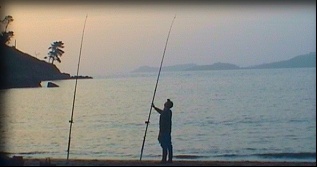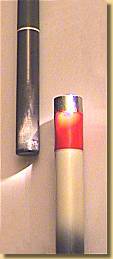
The sunset, with bites or without, the night promists to be nice.
Quiet beach.
![]()
 t the first approach and, without being an expert, we can simplify to the extreme the classification of the rods in the following way: on one side the long and soft rods and on the other side the short and stiff rods. It goes without saying that between these 2 extremes, a whole gradation of prices, types, sizes, powers, materials, actions, colors and additional details sow the disorder in the mind of somebody who would like to have a clear answer to his question : which rod do I choose for surfcasting ?
t the first approach and, without being an expert, we can simplify to the extreme the classification of the rods in the following way: on one side the long and soft rods and on the other side the short and stiff rods. It goes without saying that between these 2 extremes, a whole gradation of prices, types, sizes, powers, materials, actions, colors and additional details sow the disorder in the mind of somebody who would like to have a clear answer to his question : which rod do I choose for surfcasting ?
First of all: read the monthly magazines which regularly write articles on the subject. Of course, don't stay confined in only one paper. As for many things: take time to "digest" this technical prose. Question fishermen, look at the hardware they use, it is quite rare if you are not able to make them say some words on the rods they use. Be wary of several things: the French often shout cock-a-doodle-doo, i.e. that some tend to place in first the French trademarks. Certain journalists "work very officially" for a rod manufacturer and make comparison tables... Be critical to interpret these chronicles.
If I do not have the claim to say to you which is the ideal rod; I however will point out certain significant details here and others which are undoubtedly less significant but which will perhaps help you make yourself an idea and to bring you an "external" point of view for the choice of a rod.
The Prices
 will not give you the alms of a list of models with the prices : I will be well in sorrow to hold this list up to date and that would be of poor interest compared with the last catalogues of manufacturers that you'll find (amongst other things on internet). Eventually Refer to the links table.Eventually Refer to the links table.
will not give you the alms of a list of models with the prices : I will be well in sorrow to hold this list up to date and that would be of poor interest compared with the last catalogues of manufacturers that you'll find (amongst other things on internet). Eventually Refer to the links table.Eventually Refer to the links table.
2 points nevertheless:
Certain "abroad" prices are definitely lower (~30%) that in our Hexagonal country, I ask the question : WHY ? whereas the VAT are comparable ? And it goes like for the cars : certain French models sold abroad are less expensive than in France (same VAT!). Do we encourage French people to buy French ?
Don't "rush" on the last model from ".. Shiserplex" whose last comparative published in... "Angling Anglers news" praises innumerable qualities and merits, as the very last "carbonium?" left, etc... etc... On one hand it will cost you more ! On the other hand, you are not safe from a marketing advanced ! E.g that the first consumers make the expenses of the technical defects which will appear perhaps only after several fishing sessions; and which will be fixed in a next production lot. Therefore pay attention, not to be used as guinea-pig.
I know for my part certain people who buy systematically the last "Mitchwa" reels or "Daimano" reels which has just come out, to park it in a cabinet after 3 fishing sessions with the buddies. You surely know someone too... In addition (and the parallel with the cars or other product is not fortuitous) when a new model comes out, the price of the model it is supposed to replace immediately fall, and at this point in time it becomes interesting to acquire the old version especially if it were famous the previous years (according to the measurement of your interest, of course). The second-hand market is also a good source of supply : the many members of surfcasting clubs buy and sell more than the average (emulation obliges), so : take the opportunity.
The prices of the 2 section new rods - recent models are in general rather high (300-450 EURO), choose rather secondhand (preceding generation), less expensive and as powerful as the last models launched with heavy commercial support.
The Length
 nter a tackle store, the first thing which makes it possible to differentiate the exposed rods, it is their sizes. I hear already some which easily handle "the 5.00m" saying : "The longer the better..", "that position the line above the first waves".... (see the small sketch on scale I made, and you could be convinced of the opposite).
nter a tackle store, the first thing which makes it possible to differentiate the exposed rods, it is their sizes. I hear already some which easily handle "the 5.00m" saying : "The longer the better..", "that position the line above the first waves".... (see the small sketch on scale I made, and you could be convinced of the opposite).
I will not develop the polemic if it would be necessary to do so, each one is free of its choices and, at the very least, you cannot impose to a 1,70m gauge angler to handle comfortably a 5.00m rod. In addition, I remember an inscription "bass fishing" on a 6.50m rod (out of fiberglass); useless to say that with the best will of the world, it was difficult to exceed 50m cast with a 80g lead so the flexibility was impressive ! I pass to you the headache with a gentle breeze !
Without seeking the "exotic" XXL models or the shortened "cudgels", you can limit your choice in a range of 3.50m to 4.20m.
2 sections or 3 sections ?
It depends.., the rods in 2 strands are from English origin and often associated with spigot couplings for a maximum length of 13 feet (13 X 30,48 = 3,96 m). The rods in 3 strands and traditional haftings are rather of Latin inspiration and start at 3.80m to... never finish, but from a practical point of view you will try not to exceed 4.20m high limit.
Nevertheless pay attention to the following point : the usual 3 section rods does not exceed 1.65m once dismounted, compared to the 2 section ones which (by their construction) are more "unbalanced" : the heel is from 1.40m to 1.80m while the tip part can vary from 1.90m to 2.40m !
Then, if you choose for a 2 section rod, thus check that the 2.40m enter in your car (in diagonal), avoid to make exceed the tip by the open pane as I can still sometimes see.


spigot coupling.

Classical coupling.